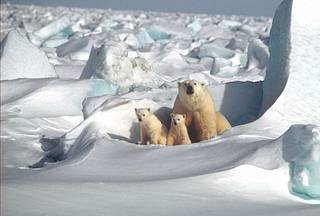
Similar
A Mom and Her Cubs (27400492256)
Summary
Ursus maritimus
USGS uses the latest technology in satellite radio-tracking to fill key information gaps on how polar bears use both the sea ice and land. Adult female polar bears are captured, fitted with satellite telemetry collars, and followed throughout their annual range. Working with the U.S. Fish and Wildlife Service, we're also experimenting with glue-on and ear tag satellite transmitters, which can be deployed on adult male bears and younger, still-growing bears.
Polar bears are tied to the sea ice for nearly all of their life cycle functions. Most important of these is foraging, or access to food. Polar bears almost exclusively eat seals, and they are equally as dependent upon the sea for their nutrition as are seals, whales, and other aquatic mammals. Polar bears are not aquatic, however, and their only access to the seals is from the surface of the sea ice. Over the past 25 years, the summer sea ice melt period has lengthened, and summer sea ice cover has declined by over half a million square miles. In winter, although sea ice extent has not changed as greatly, there have been dramatic reductions in the amount of old ice, predominantly in the western Arctic. This loss of stable old ice has set up additional losses of sea ice cover each summer because the thinner younger ice is more easily melted during the recent warmer summers.
You can read more about polar bear research, sea ice, and access current tracking maps of polar bears at on.doi.gov/PolarBearTracking
Photo by: Steven Amstrup, USGS, 2001
Date
Source
Copyright info















